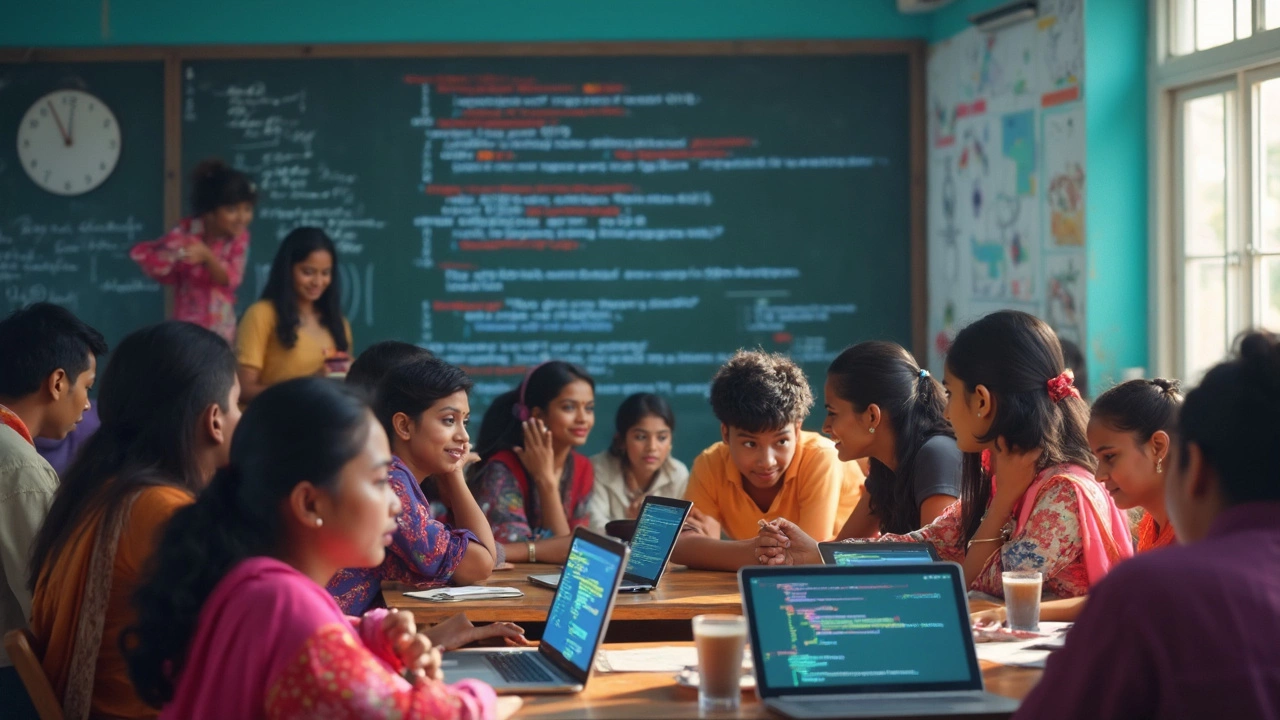Picking your first coding language feels a lot like staring at a whole aisle of cereal. There are endless choices, each with their own weird perks and confusing labels. But trust me—what matters most is picking one and sticking with it long enough to understand the basics. You don’t need to get caught up in hype or what “real programmers” say online.
So, why stress about your first language? Because each one was made for different reasons, and some are way friendlier for beginners. Trying to learn C++ on day one is like trying to run a marathon when you can barely jog. But something like Python? Way easier to chew, and it actually lets you build cool stuff pretty fast.
- Why Even Care Which Code to Learn First?
- Python: The No-Stress Favorite
- If You Like Making Websites—HTML, CSS, and JavaScript
- Game Changers: Java, C#, and Beyond
- Surprising Stuff People Forget to Consider
- Quick Tips for Picking and Sticking With It
Why Even Care Which Code to Learn First?
This isn’t a trick question—your first coding language honestly matters. Think of it like picking your first bicycle: you wouldn’t jump on a racing bike before mastering the basics. Some languages make it way easier to get rolling, while others toss you right into the deep end.
The main reason folks get stuck or quit is frustration. A language with messy syntax or a steep learning curve will just make you want to throw your laptop out a window. That’s why so many coding classes push a beginner-friendly language—less time debugging, more time actually building stuff that works.
Different programming languages are built for different jobs. Want to build websites? You’ll need one thing. Apps? Something else. There’s no "one size fits all." For example, Python is famous because universities, startups, and even Google use it for everything from apps to AI. JavaScript is the soul of interactive websites, while Java and C# run behind tons of business software and mobile apps.
- Learning the wrong language can slow you down, especially if it doesn’t match your goal.
- Switching languages later isn’t impossible, but the early learning curve can push people away.
- Your first success in coding boosts your confidence and keeps you going. Don’t miss out on that.
Here’s a quick look at which languages are most popular with newbies, according to a 2024 Stack Overflow survey:
| Language | Beginner-Friendliness | Popular Use |
|---|---|---|
| Python | Easy | Web, Data, AI |
| JavaScript | Easy | Web, Apps |
| Java | Medium | Apps, Android |
| C# | Medium | Games, Business |
| C++ | Hard | Games, Systems |
So, picking the right language to learn first isn’t just about what sounds cool. It’ll make everything more doable, less annoying, and way more fun. That way, you actually stick with it—and that’s how you win.
Python: The No-Stress Favorite
If you stop random coders and ask what you should learn first, most will say Python—there’s a reason for that. Python’s code almost reads like regular English, which makes it perfect for folks who want to actually see what their programs are doing instead of getting lost in weird punctuation or semi-colons. It was even named after the British comedy group 'Monty Python,' not the snake, because its creator thought coding should be fun. That vibe really stuck.
The sheer size of Python’s community is a lifesaver. Got a weird error? There’s probably already an answer online. Need to build something fast, like a website, a small game, or even a basic robot? There’s a Python library for nearly everything. That’s why schools and bootcamps usually start with it.
Here’s how Python stands out for beginners:
- Simple, clear syntax—looks almost like normal sentences
- Works on Windows, Mac, and Linux with almost zero setup headaches
- Huge library support for everything from data analysis to web builds
- Top pick in coding classes—used by big companies like Google and Netflix
Still on the fence? Check out this quick comparison table. It shows just how much Python dominates as a first language in coding classes and job requirements:
| Language | Average Salary (US) | Beginner-Friendly | # of Libraries | Main Uses |
|---|---|---|---|---|
| Python | $120,000 | Yes | ~300,000 | Web, data, automation |
| JavaScript | $110,000 | Kinda | ~160,000 | Web, apps |
| Java | $105,000 | Not really | ~120,000 | Apps, servers |
If you just want a reliable coding class launchpad and don’t want to stress about tricky errors or setup, Python is your best bet. You’ll spend more time making real things, less time pulling your hair out. Even Luna (my cat) could probably learn print('Hello, world!').
If You Like Making Websites—HTML, CSS, and JavaScript
If your dream is to build websites—think online shops, blogs, or even simple portfolios—there’s really no way around these three: HTML, CSS, and JavaScript. Each one plays a different role. Don’t let anyone convince you that you can skip one and still make something real for the web.
Here’s how they break down:
- HTML (HyperText Markup Language): This is the bones and structure. Everything you see on a website—headings, links, buttons—starts here. It’s not “programming” in the fancy sense, but you can’t have a site without it.
- CSS (Cascading Style Sheets): Makes things pretty. Colors, layouts, fonts—this is the styling layer. Want your website to look less like Craigslist? This is where the magic happens.
- JavaScript: Adds life. Pop-ups, cool animations, dropdown menus, instant feedback when you fill out a form—JavaScript does all of that. It’s the actual programming language out of the three, and can be tricky at first. But every modern website uses it somewhere.
Most coding classes for beginners cover all three because you can’t build anything practical without them as a set. HTML and CSS are usually quick to pick up. JavaScript takes some extra effort, but the payoff is huge—knowing it means you can make websites that actually do stuff, not just look pretty.
Just check out how wildly popular these skills are in job listings:
| Skill | Web Developer Job Posts Mentioned (%) |
|---|---|
| HTML | 98% |
| CSS | 97% |
| JavaScript | 94% |
That’s nearly every employer in the web space asking for all three. If you want proof, my friend once tried applying as a "web developer" with zero JavaScript skills—his resume got ghosted immediately, even for unpaid gigs. So, tackle them together—and don’t skip projects. Building even a basic site for yourself is way more useful than finishing a million little exercises.
One more tip: there are tons of free tools to practice. Try CodePen or JSFiddle to mess around right in your browser, no downloads needed. If you can make a simple to-do list app, you’re already doing better than most people who just say they’re learning web stuff. Want bragging rights? Try building your own cat photo gallery with HTML, CSS, and JavaScript—bonus points if you name it after Luna, like I did with my own cat.

Game Changers: Java, C#, and Beyond
If Python is the comfy hoodie of coding, Java and C# are like solid work boots—built for big stuff and made to last. These languages are massive in the professional world, especially if you’re eyeing careers in app development, enterprise software, or even game design. They’re a bit tougher to learn than some beginner-friendly languages, but that’s mostly because they teach you habits that top tech companies care about. For example, Java powers things from Android phones to bank systems, while C# is the backbone of tons of Windows apps and games using the Unity engine.
Plenty of colleges and coding classes use Java as their teaching language because it drives home the basics of "object-oriented programming" (think of it like digital Lego blocks that snap together). C# is no slouch either, especially if you want to experiment with game design—Unity uses C# almost exclusively, and there are more than 2.5 billion Unity-powered games out there right now.
- Java is used by around 9 million developers globally.
- C# is the language of choice for nearly all games made on Unity.
- Both are in the top 10 most popular programming languages (checked as of May 2025).
Here's a quick head-to-head to make the differences clearer:
| Language | Main Use | Pros | Cons |
|---|---|---|---|
| Java | Android apps, banking, enterprise software | Wide job market, huge coding community, portable | Can feel strict and wordy |
| C# | Windows apps, Unity games | Great for games, clear syntax, strong support on Windows | Mostly tied to Microsoft tools |
If you’re after an in-demand job, or you love the idea of making your own game or app, learning Java or C# is a smart move. Don’t worry if it feels a bit heavy at first. After wrestling with one of these, going back to languages like Python or JavaScript will almost feel easy. And if you use reliable coding classes, you get plenty of exercises that help you actually remember what you’re learning—not just copy and paste random code.
Bottom line: If your dream is to work at a big tech company, build a bank app, or design the next hit game, Java and C# are totally worth the climb. Pick one that matches what you want to make, and you’ll never regret investing the time.
Surprising Stuff People Forget to Consider
Most folks jump into learning a programming language without thinking about some sneaky-but-important factors. It’s not just about which language looks cool or which one your friends use. Here are a handful of things that usually get ignored, but can really change your experience for better or worse.
- Time to First Success: You don’t want to be stuck on boring theory forever. Some languages let you get results faster, which keeps you motivated. For example, in Python, you can build a simple calculator or web scraper within an hour or two. With C, plan on a few hours just to get your first successful output.
- Community Size and Support: Ever tried to Google a question about a new topic and found nothing? Frustrating, right? The bigger the community, the easier it is to find answers. Python and JavaScript have massive communities. Something obscure like Erlang? Not so much.
- Job Market and Earning Power: If you’re chasing a better paycheck, you should check real data on demand. Here’s a quick look at median U.S. salaries for a few languages, pulled from Stack Overflow’s 2024 Developer Survey:
| Language | Median U.S. Salary ($) |
|---|---|
| Python | 130,000 |
| JavaScript | 120,000 |
| Java | 125,000 |
| C++ | 135,000 |
That’s some real motivation if you’re hoping to swap careers.
One more thing people forget: ease of setup. Some languages, like C++ or Java, make you install big toolkits and set variables just to write “Hello, world.” With coding classes teaching Python or JavaScript, you can code straight from your browser—no mess, no headache.
Finally, don’t ignore your own learning style. Some people lose interest fast if they don’t see results. If that’s you, look for a language with instant feedback and lots of “try it yourself” sites or sandbox tools.
So, don’t just jump on what’s trending or what someone on Reddit says is the “best.” Consider what fits your actual needs, your patience level, and where you want to end up.
Quick Tips for Picking and Sticking With It
If you’re feeling overwhelmed about choosing your first programming language, don’t sweat it. Here’s what actually helps you start—and finish—what you set out to do.
- Focus on just one language. Juggling Python, JavaScript, and Java on day one just leads to confusion. Pick one and run with it for at least a couple of months.
- Align your choice with your goals. Want to make websites? JavaScript is the bread and butter. Dreaming about data analysis or automating boring stuff? Python will get you moving faster. Have a favorite app or game you love? Look up what language it uses. You’ll be way more invested.
- Don’t chase the "trending" language every month. Trends come and go, but fundamentals stick around forever. For example, Python has stayed in the top three most popular languages for the last five years, according to the TIOBE Index.
- Plan for small wins. If you can print “Hello, World!” or make a simple to-do list app after your first week, you’re on the right track. Small victories make the grind much easier.
- Consistency beats cramming. Rather than doing ten hours in one burst and burning out, aim for 20-30 minutes every day. That works way better for building real skill.
- Join an online community—or even just a Discord group. There’s usually someone who’s stuck at the exact place you are, or who just figured out the bug you’re fighting.
Just to give you an idea of how much time beginners usually put in, check out this recent data from Stack Overflow’s 2024 survey:
| Learning Schedule | Percentage of Beginners |
|---|---|
| Less than 30 minutes daily | 24% |
| 30-60 minutes daily | 38% |
| One or two big weekend sessions | 19% |
| Inconsistent/when mood strikes | 19% |
If you can get into the habit of consistent, short practice, you’re already ahead of most people who sign up for coding classes and quit too soon. Keep it simple, track your progress, and don’t forget to celebrate the tiny “aha!” moments. They stack up faster than you think.



